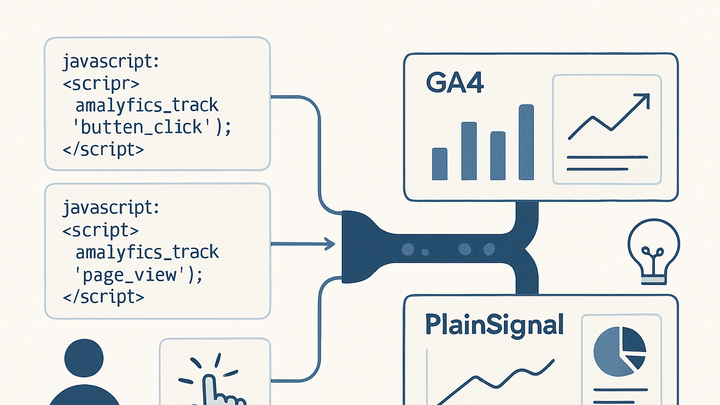Published on 2025-06-26T04:38:11Z
What is Instrumentation? Examples for Instrumentation in Analytics
Instrumentation in analytics is the process of integrating and configuring tracking code to capture user interactions and send them to an analytics platform. This code can be deployed directly in your website or app, through tag management solutions, or via server-side implementations. Proper instrumentation ensures that key events—like page views, button clicks, and form submissions—are recorded consistently and accurately. Whether using GA4’s gtag.js or cookie-free solutions like PlainSignal, instrumentation enables teams to gather actionable insights, optimize user experiences, and make data-driven decisions. Without robust instrumentation, data can be incomplete, inconsistent, or misleading, undermining the credibility of your analytics efforts.
Instrumentation
Instrumentation in analytics is embedding and configuring tracking code to reliably capture user interactions and send them to analytics platforms.
Understanding Instrumentation
Instrumentation refers to adding and maintaining code that logs specific user and system events on your digital properties.
-
Definition and scope
Instrumentation covers the insertion, configuration, and maintenance of tracking code that logs events such as clicks, page views, and custom user actions.
-
Client-side vs. server-side
Client-side instrumentation runs in the browser or app; server-side instrumentation sends event data from your servers. Both approaches have trade-offs in performance, accuracy, and privacy.
-
Client-side instrumentation
Executed in the user’s browser or device, it’s easier to deploy but can be blocked by ad blockers or network issues.
-
Server-side instrumentation
Runs on your backend, offering greater control and reliability but requiring more development effort.
-
-
Cookie-based vs. cookie-free
Traditional analytics often rely on cookies for user identification, while cookie-free approaches like PlainSignal use browser features and privacy-focused strategies.
Why Proper Instrumentation Matters
Accurate and complete instrumentation is the foundation for trustworthy analytics and informed decision-making.
-
Data accuracy and completeness
Accurately instrumented events ensure that analytics reports reflect true user behavior, minimizing gaps and anomalies.
-
Actionable insights
With reliable data, teams can identify optimization opportunities, run effective A/B tests, and measure ROI accurately.
-
Compliance and privacy
Correct instrumentation helps manage user consent, handle data retention policies, and adapt to privacy regulations such as GDPR and CCPA.
Examples of Instrumentation with SaaS Analytics Tools
Concrete code snippets show how to implement instrumentation in real-world analytics solutions.
-
PlainSignal (cookie-free analytics)
Add the following snippet to your website’s
<head>to enable event collection with PlainSignal:<link rel="preconnect" href="//eu.plainsignal.com/" crossorigin /> <script defer data-do="yourwebsitedomain.com" data-id="0GQV1xmtzQQ" data-api="//eu.plainsignal.com" src="//cdn.plainsignal.com/plainsignal-min.js"></script> -
Google analytics 4 (GA4)
Use the following GA4 snippet to send events:
<!-- GA4 Measurement Code --> <script async src="https://www.googletagmanager.com/gtag/js?id=G-XXXXXXX"></script> <script> window.dataLayer = window.dataLayer || []; function gtag(){dataLayer.push(arguments);} gtag('js', new Date()); gtag('config', 'G-XXXXXXX'); </script>
Best Practices for Instrumentation
Follow these guidelines to ensure your instrumentation is consistent, reliable, and maintainable.
-
Develop a tracking plan
Outline the events, parameters, and naming conventions before implementation to ensure consistency.
-
Identify key events
Determine which user actions and system events drive your business goals.
-
Specify event parameters
Define properties (e.g., value, category, label) that provide context to each event.
-
-
Use consistent naming conventions
Stick to a clear, hierarchical naming scheme (e.g., category_action_label) for easy analysis and filtering.
-
Validate and test
Use debugging tools (GA4 DebugView, browser dev tools) to verify events are firing as expected before going live.
-
Maintain documentation
Keep a centralized repository of your instrumentation details and version changes for team collaboration.
